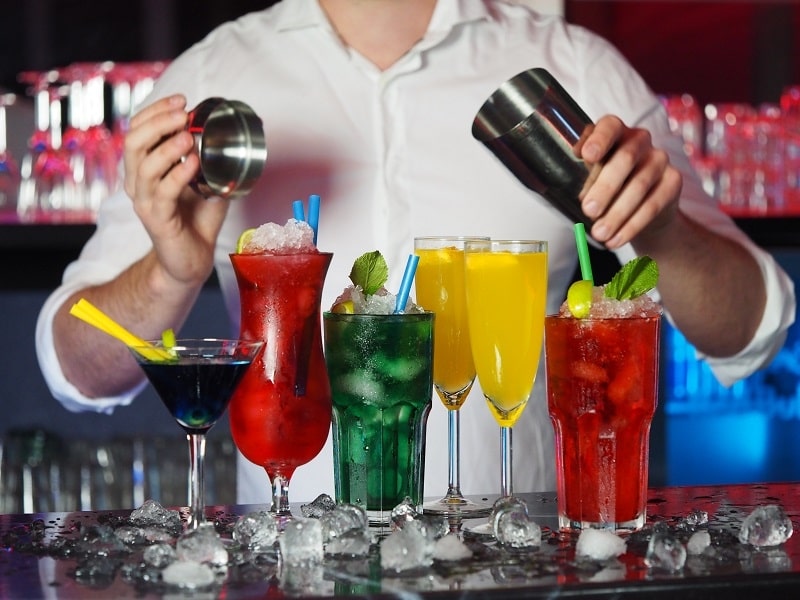Are Irish Car Bombs Really Irish? Debunking Cocktail Myths
As you sip that martini from your classy personalized glassware, you might begin to wonder: where did this drink get its name from? Is an Irish car bomb really Irish? Is the Moscow mule really from Russia?
The cocktails we find on bar menus often have the most outrageous names imaginable – where did they come from? In today's guide, the Paykoc Imports team dives into the world of drink etymology to uncover how they really for their monikers.
Irish Coffee
Before horrendous "energy drink"/alcohol combos like Four-Loko hit gas station shelves, caffeine fiends and aficionados enjoyed mixing their substances with old-fashioned "Irish coffee" – also known as "Liqueur Coffee."
The Irish coffee is a jarring blend of whiskey (preferably, of the Irish variety for authenticity's sake), coffee, sugar, and cream.
The origins of Irish coffee can be traced back to French cocktail entrepreneurs of the 19th century. These pioneers of coffee/alcohol combos mixed spirits with the stimulant beans to create concoctions called gloria.
There remains some dispute over who invented the Irish coffee as it is known today – the specific mix of cream, sugar, coffee, and Irish whiskey – but it is generally credited to Joe Sheridan of County Limerick, Ireland.
Unfortunately, the big coffee chains like Starbucks have refused to incorporate the hard stuff into their menus, so they remain woefully absent of Irish coffees on offer.
The Moscow Mule
Chances are you've seen a hipster or five at your local artisanal café, sipping Moscow mules from sophisticated custom glassware.
Any name with the word "Moscow" in it conjures up imagery of frigid North European winters on the vast Eurasian steppes, of huddled Russians warming their bodies with hard vodka.
However, the Moscow mule cocktail has very little to do with either Moscow or with mules. It was actually created far, far away in Los Angeles in the 1940s.
The Moscow mule –one part ginger beer, one part lime juice, one part vodka – earned its name because, at the time, vodka was still somewhat of an exotic elixir, associated strongly with Russia. This might seem strange in the modern context of Absolut on sale at every liquor store, but back then Americans had not yet acquired the palate for vodka.
Hence, anything with the potato-derived spirit earned some sort of name reminiscent of Mother Russia. Speaking of which...
White Russian
The Big Lebowski fans will recall The Dude's fondness for White Russians.
Ingredients-wise -- one part vodka, one part coffee liqueur, one part cream -- the White Russian is not wildly dissimilar from an Irish Coffee, save for the type of spirit.
The term White Russian is a derivative of Black Russian, which was the same drink minus the cream. The drink first appeared in Belgium around the mid-20th century. Again, it earned its name because of its primary ingredient, vodka, which is forever linked with Russia in the popular imagination.
The Irish Car Bomb
Perhaps the most entertainingly named drink in world history, the Irish Car Bomb earned its name from a combination of one of its primary ingredients, Guinness, and the many automobile explosions that went off during "The Troubles" in Ireland in the 1900s – the long-standing conflict between Irish nationalists and the British commonwealth "occupiers" that brewed for 800 years before "blowing up" (literally and figuratively) with a rash of car bombings.
The drink is made by dropping a shot of Irish whiskey into customized glassware full of Guinness beer – hence the "explosion."
However, the Irish car bomb is not a product of Ireland. Rather, the drink was first pioneered in Norwich, Connecticut. The Irish are sensitive to this fact, and many bars in Ireland to this day refuse to make the drink as a point of national pride.
The Cosmopolitan
This classy drink, which conjures images of Manhattan socialites enjoying their high-brow cocktails from custom glassware in some upscale lounge-bar, is somewhat dubious in terms of origin.
The popular working theory is that it first appeared in the national consciousness in Miami Beach in the early 1980s. the drink is basically of variation on the Kamikaze, but with cranberry juice substituted for the typical lime juice. According to the theory, this made the drink more palatable to female customers who tended to be put off by the sourness of the Kamikaze.
However, other accounts claim that the cosmopolitan was actually invented in New York in 1987.
Regardless, this now-classic (and classy drink) – containing Triple Sec, vodka, ice, and cranberry juice – remains very urban in its appeal to this day. Chances are you won't, for example, find many cosmopolitan connoisseurs in a Montana bar.
Bloody Mary
Perhaps no single drink in history has a more awe-inspiring name than the Blood Mary. Speculation about the origins of the name has run rampant for nearly a century since it first gained popularity.
The drink – which includes tomato juice, vodka, and any number of added herbs and spices – was first created in the 1920s by a French bartender named Fernand Petiot. Others have laid claim to its creation, but this origin story is the most credible.
However, like the identity of its creator, the origins of the name are still up for dispute. Some believe it is a bastardization of a Slavic drink translating to "Vladimir" in English. Other stories claim it was a reference to a patron of the bar where Petiot worked.
The history of these cocktails and more – and the customized glassware in which they are served – is ripe with quizzical twists and turns.

 Default Currency
Default Currency
